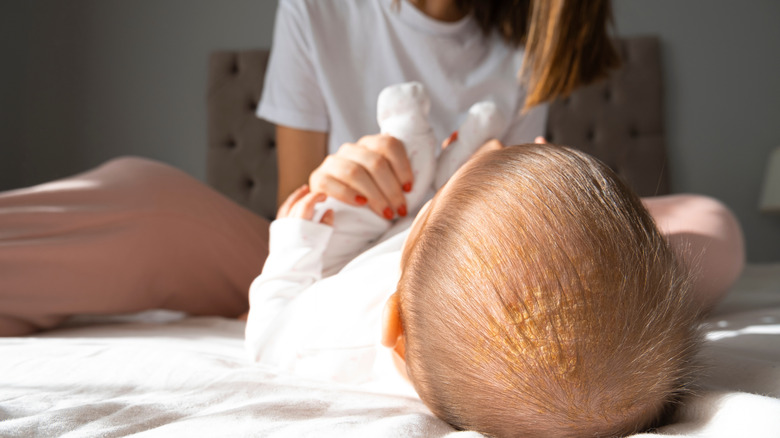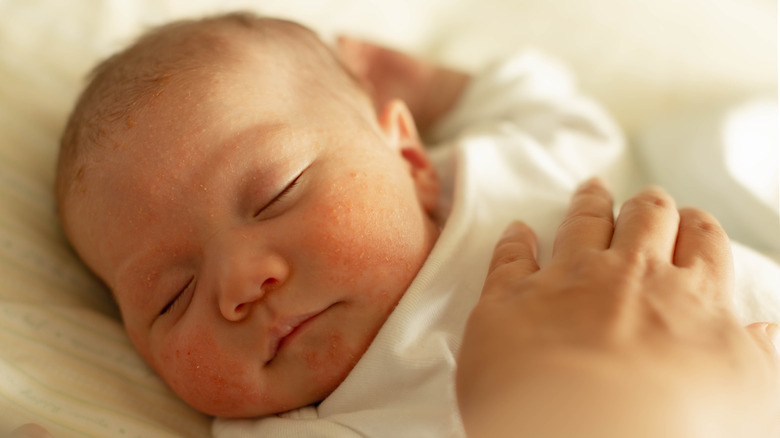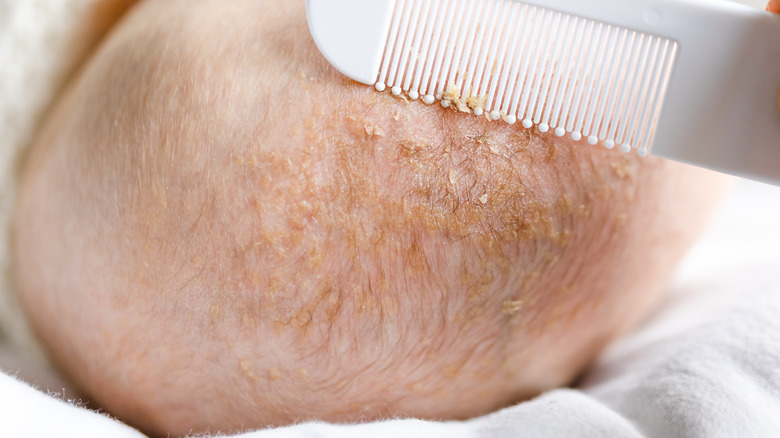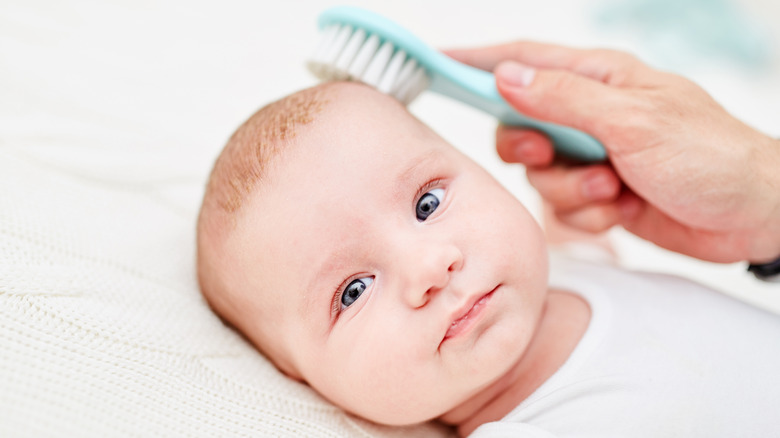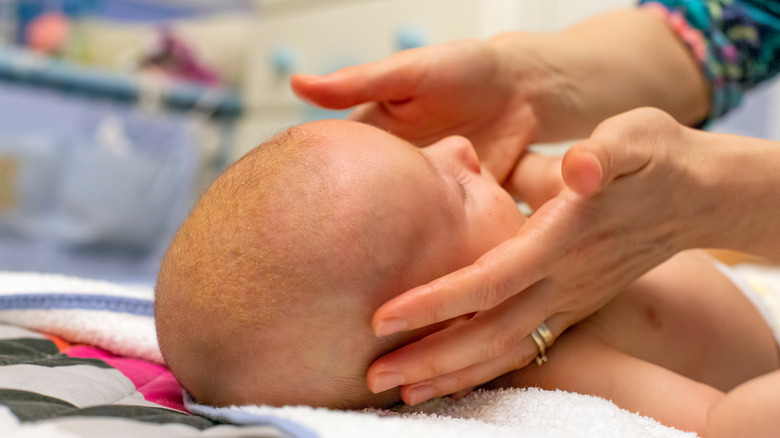What To Do If Your Baby Has Cradle Cap
Babies have delicate and sensitive skin that's usually susceptible to conditions like cradle cap, also known as seborrheic dermatitis, which usually occurs on the scalp, chest, face, back, groin, and armpits (via the American Family Physician). It often appears as a greasy, scaly, and yellowish rash within the first three months of a baby's life (via MedicalNewsToday). As many as 7 in 10 babies develop cradle cap between the second and sixth week, says the Cleveland Clinic.
Even though cradle cap is common, it's rarely harmful. According to Healthline, it's a short-term condition. Furthermore, most cradle cap cases are benign, and symptoms usually clear up on their own between 6 and 12 months, says the American Academy of Dermatology Association.
However, not all cradle cap cases are the same and severe cases might result in various complications. What's more, it's important to resist the temptation to pick the scales with your fingernails since this can lead to bleeding or infections, says the Cleveland Clinic.
Not knowing what to do if a baby has cradle cap can be frustrating. That's why it's important to learn more about the condition and the general symptoms.
Causes of cradle cap
Contrary to what many think, cradle cap has little to do with hygiene. According to Johns Hopkins Medicine, the condition doesn't stem from an infection or an allergy either. Although the exact cause isn't known, doctors suspect that a combination of factors may lead to cradle cap.
According to Nemours Children's Health, babies may develop cradle cap due to excess sebum in their hair follicles and oil glands. WebMD adds that the extra oil that builds up in the skin can result in dead skin cells sticking to the scalp.
According to the Mayo Clinic, cradle cap may develop due to the growth of a yeast (or fungus) known as Malassezia. This yeast sometimes grows in the sebum along with bacteria.
Besides these external factors, cradle cap can be caused by hormones passed from mother to baby. Excess hormones cause the baby's oil glands and hair follicles to produce too much oil, allowing dead skin cells to stick to the scalp.
According to the Cleveland Clinic, babies with a genetic predisposition to eczema or asthma can also develop cradle cap.
Symptoms of cradle cap
According to Johns Hopkins Medicine, the symptoms of cradle cap can differ from one baby to the next. While it might look irritating or uncomfortable on your baby's skin, it rarely bothers them, says Nemour Kids Health.
The condition usually causes slightly red and crusty patches on the scalp. However, patches can appear crusty yellow in some cases. Besides the scalp, the rash can appear on your baby's face or diaper area, spreading to other parts of the body with time. According to the Mayo Clinic, babies develop white or yellow flakes that can appear on oily or dry skin, especially on the ears, nose, eyelids, and groin. Cradle cap can also cause non-cutaneous symptoms such as hair loss. However, hair loss due to cradle cap is rare, and hair will most likely grow back after the condition goes away (via WebMD).
Home remedies for cradle cap
Although cradle cap usually clears up without treatment, you can use various home remedies to loosen the scaly patches.
According to the American Academy of Dermatology Association, washing your baby's hair more frequently will help soften the scales. The academy advises choosing fragrance-free baby shampoos. Mayo Clinic reiterates the importance of adopting the right washing technique. The clinic advises washing the hair daily, applying mineral oil to the scalp for a few hours before shampooing, and soft-brushing the scalp. After shampooing and brushing your baby's hair, WebMD advises rubbing petroleum jelly, baby oil, or ointment into your baby's scalp.
According to Mayo Clinic, 2% antifungal ketoconazole medication or low-potency hydrocortisone creams can be safe alternatives to explore. Note that some over-the-counter antifungal and cortisone creams may be harmful to your baby's skin. Therefore, it's best to follow the recommendations of a dermatologist.
How to prevent cradle cap
Since prevention is better than cure, it's important to keep up with your baby's skincare regimen even if they've recovered from a previous case of cradle cap. According to Johns Hopkins Medicine, using a soft-bristled brush or fine-toothed comb and rubbing baby oil into the scalp may help prevent the future build-up of scales.
Healthline advises gently massaging the affected area, which will help relax your baby and might prevent worse episodes of the condition — since stress can trigger flare-ups and make your baby uncomfortable. Often, babies flail their arms and legs when they're stressed. Other signs of stress include frowning, squirming, or frequent yawning. If you notice any signs of stress, Healthline recommends being aware of your baby's sleeping patterns. Approximately 14 to 17 hours of daily sleep is needed for newborns, according to Healthline.
It's also important to check for any nutritional deficiencies if you suspect nutrition to be the root cause of your child's condition. It's best to consult a doctor or nutritionist for an appropriate diagnosis.
When to see a doctor
According to MedicalNewsToday, more severe cradle cap cases may come with bleeding and cracked areas may become infected with bacteria. It's important to visit a doctor if symptoms are accompanied by unexplained redness, irritation, or diarrhea, or if they spread to other body parts. Such scenarios require medical attention.
Healthline reiterates that scaly patches are unlikely to spread to the face and other body parts. Sometimes, the area in and around the patches may become inflamed or infected, which may not improve their own. A doctor's visit is vital in such cases. The same applies when the scales on your baby's skin crust over or secrete liquid.
According to the American Association of Dermatology Association, cradle cap usually comes without pain or itching. However, medical assistance might be needed if your baby's skin begins to break or if an itch is present. Assistance might also be required if your baby's hair starts falling out or a foul odor emerges from the rash. Other changes to watch out for include liquids draining from the rash and large crusts or scabs forming on the skin, says the Cleveland Clinic.
The Cleveland Clinic also recommends seeing a doctor if your baby experiences cradle cap symptoms beyond the baby's 12th month. When visiting a doctor, you might be asked to provide details on how long the condition has been present and the treatment options applied so far to help your doctor determine new remedies that can work best, says the Mayo Clinic.

